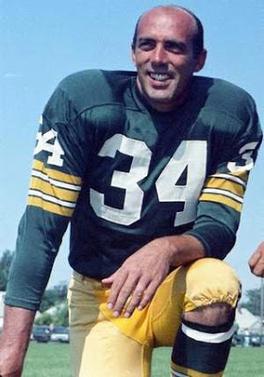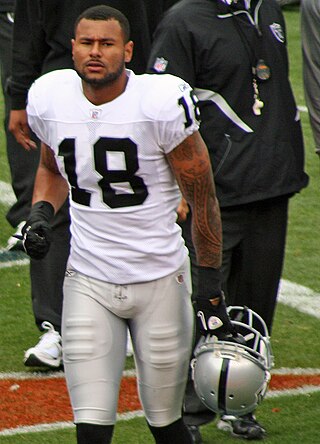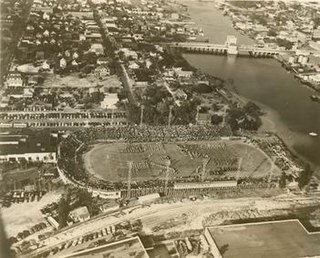
Tampa Stadium was a large open-air stadium located in Tampa, Florida, which opened in 1967 and was significantly expanded in 1974–75. The facility is most closely associated with the Tampa Bay Buccaneers of the National Football League, who played there from their establishment in 1976 until 1997. It also hosted two Super Bowls, in 1984 and 1991, as well as the 1984 USFL Championship Game. To meet the revenue demands of the Buccaneers' new owners, Raymond James Stadium was built nearby in 1998, and Tampa Stadium was demolished in early 1999.

The University of Tampa (UT) is a private university in Tampa, Florida. It is accredited by the Southern Association of Colleges and Schools. UT offers more than 200 programs of study, including 22 master's degrees and a broad variety of majors, minors, pre-professional programs, and certificates.
Idrees Kenyatta Walker is a former professional American football player who was an offensive tackle in the National Football League (NFL) for six seasons. Walker played college football for the University of Florida. A first-round pick in the 2001 NFL Draft, he played professionally for the Tampa Bay Buccaneers of the NFL.
D'Tanyian Jacquez "Quezi" Green is an American former college and professional football player who was a wide receiver and punt returner in the National Football League (NFL) for five seasons during the 1990s and early 2000s. Green played college football for the University of Florida, and earned All-American honors. He was a second-round pick in the 1998 NFL Draft, and played professionally for the Tampa Bay Buccaneers, the Washington Redskins and the Detroit Lions of the NFL.
Errict Undra Rhett is an American former professional football player who was a running back in the National Football League (NFL) for seven seasons during the 1990s and early 2000s. Rhett played college football for the University of Florida, and was recognized as an All-American. A second-round pick in the 1994 NFL Draft, he played professionally for the Tampa Bay Buccaneers, Baltimore Ravens and Cleveland Browns of the NFL.

Donald Gene "Babe" Chandler was a professional American football player. He was a punter and placekicker in the National Football League (NFL) for 12 seasons in the 1950s and 1960s. Chandler played college football for the University of Florida, and thereafter, he played professionally for the New York Giants and the Green Bay Packers of the NFL.
Thomas Johnson "John" Reaves was an American college and professional football player who was a quarterback for 11 seasons in the National Football League (NFL) and three seasons in the United States Football League (USFL) during the 1970s and 1980s. Reaves played college football for the University of Florida, and earned All-American honors.
James Clarence Harrell, Jr. is an American former college and professional football player who was a linebacker in the National Football League (NFL) and the United States Football League (USFL) for nine seasons during the 1970s and 1980s. He played college football for the University of Florida, and thereafter, he played professionally for the Detroit Lions and Kansas City Chiefs of the NFL and the Tampa Bay Bandits of the USFL.

Louis Morris Murphy Jr. is a former American football wide receiver. He played college football for the University of Florida, where he was a member of two BCS National Championship teams. The Oakland Raiders drafted him in the fourth round of the 2009 NFL Draft, and he has also played for the Carolina Panthers, New York Giants, Tampa Bay Buccaneers, and San Francisco 49ers.
John Richard Symank was an American college and professional football player who was a defensive back in the National Football League (NFL) for seven seasons during the 1950s and 1960s. Symank played college football for the University of Florida, and thereafter, he played professionally for the Green Bay Packers and St. Louis Cardinals of the NFL. He was later the head coach for Northern Arizona University and the University of Texas at Arlington football teams.

The Tampa Spartans are the athletic teams that represent the University of Tampa, located in Tampa, Florida, in NCAA Division II intercollegiate sports. The Spartans compete as members of the Sunshine State Conference for all sports besides beach volleyball and track and field, which compete as independents. Tampa has been a member of the conference since 1981.

Dan Clement Fike, Jr. is an American former college and professional football player who was an offensive lineman in the National Football League (NFL) for eleven seasons during the 1980s and 1990s. He played college football for the University of Florida, and thereafter, he played professionally for the New York Jets, the Cleveland Browns and the Pittsburgh Steelers of the NFL.

Plant Field was the first major athletic venue in Tampa, Florida. It was built in 1899 by Henry B. Plant on the grounds of his Tampa Bay Hotel to host various events and activities for guests, and it consisted of a large field ringed by an oval race track flanked by a large covered grandstand on the western straightaway with portable seating used to accommodate a wide variety of uses. Over the ensuing decades, Plant Field drew Tampa residents and visitors to see horse racing, car racing, baseball games, entertainers, and politicians. The stadium also hosted the first professional football and first spring training games in Tampa and was the long-time home of the Florida State Fair.
Vincent Kendrick was an American former college and professional football player who was a running back in the National Football League (NFL) for two seasons during the 1970s. Kendrick played college football for the University of Florida, and thereafter, he played professionally for the Atlanta Falcons and Tampa Bay Buccaneers of the NFL.

Ahmad Black is a former American football safety who played for the Tampa Bay Buccaneers of the National Football League (NFL). He played college football for the University of Florida, and was a member of a BCS National Championship team. Black was drafted by the Buccaneers in the fifth round of the 2011 NFL Draft. Black officially retired from the NFL on April 9, 2017.
Eugene William McCaslin, Jr. is an American former college and professional football player who was a linebacker in the National Football League (NFL) for a single season. He played college football for the University of Florida. He was drafted late in the seventh round of the 2000 NFL Draft, and played professionally for the NFL's Green Bay Packers.
Lee Colson McGriff is an American former college and professional football player who was a wide receiver in the National Football League (NFL) for a single season in 1976. McGriff played college football for the Florida Gators football team of the University of Florida. Thereafter, he played professionally for the Tampa Bay Buccaneers in their inaugural season in 1976.
The 1963 Tampa Spartans football team represented the University of Tampa in the 1963 NCAA College Division football season. It was the Spartans' 27th season. The team was led by head coach Fred Pancoast, in his second year, and played their home games at Phillips Field in Tampa, Florida. They finished with a record of four wins, five losses and one tie (4–5–1). Pancoast resigned as the Spartans' head coach on January 20, 1964, to take the position of ends coach at Florida.
Alvis Russell Darby is an American former college and professional football player who was a tight end for two seasons in the National Football League (NFL). Darby played college football for the University of Florida, and was chosen by the Seattle Seahawks in the sixth round of the 1976 NFL Draft. He also played professionally for the NFL's Houston Oilers and Tampa Bay Buccaneers.

Phillips Field was a medium-sized stadium located on the west bank of the Hillsborough River across from downtown Tampa, immediately adjacent to the University of Tampa. It opened on October 4, 1937 and was the home field of the University of Tampa Spartans football program from 1937 to 1967. The facility was named for local businessman I. W. Phillips, who donated the land to the school so that the Spartans would not have to share nearby Plant Field, which was often unavailable due to its use for many different sports and community events.









